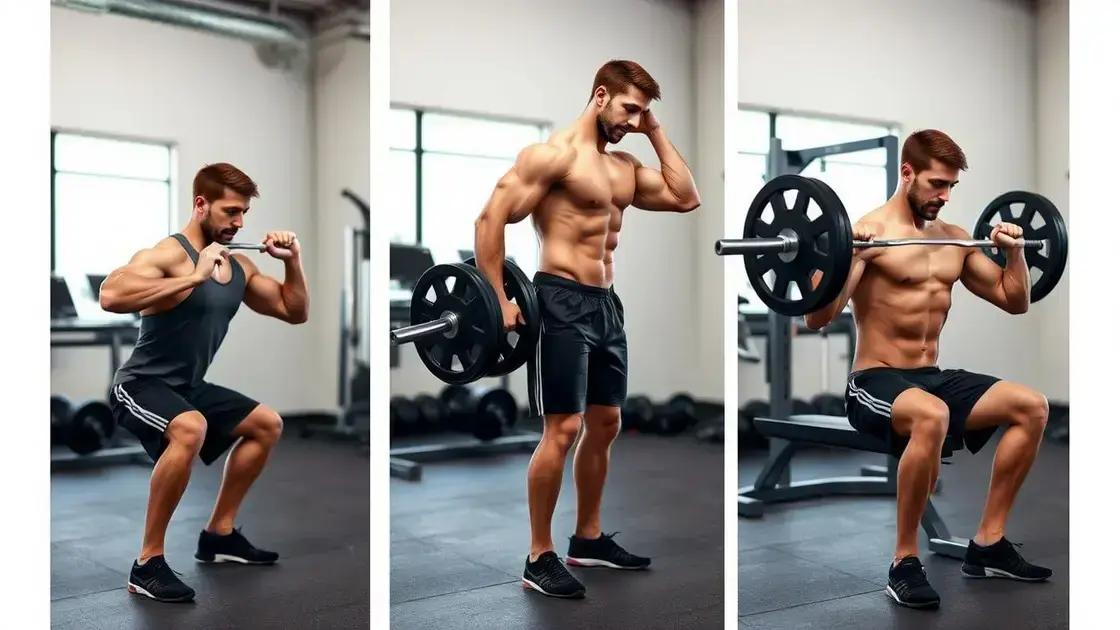Building a routine with compound movements only enhances strength and efficiency in workouts by engaging multiple muscle groups. Key benefits include improved functional strength, increased metabolism, and better time management. Incorporate a variety of exercises, prioritize proper form, and ensure rest and recovery for optimal results.
Building a routine with compound movements only is essential for anyone looking to maximize their workout effectiveness. These exercises engage multiple muscle groups, making them a time-efficient way to build strength and improve overall fitness. In this post, we’ll dive into understanding compound movements, their benefits, how to create a tailored routine, and some tips for ensuring your success with these powerful exercises.
Understanding Compound Movements

Understanding compound movements is crucial for anyone looking to optimize their fitness routine. These exercises involve multiple joints and muscle groups, which makes them effective for building strength, enhancing coordination, and improving overall performance.
Examples of compound movements include exercises like squats, deadlifts, bench presses, and pull-ups. Each of these movements engages various muscles simultaneously, allowing you to get more done in less time. This is why they are often favored in strength training programs.
How Compound Movements Work
When you perform a compound movement, your body works as a unit. For instance, during a squat, your legs, core, and even upper body engage to complete the motion. This engagement means that you can lift heavier weights safely, thereby enhancing muscle growth and strength.
Why Choose Compound Movements
Incorporating compound movements into your routine can lead to greater functional fitness. This means not only will you get stronger, but you’ll also improve your ability to perform daily tasks. By training multiple muscle groups at once, you develop better movement patterns and coordination.
The Efficiency Factor
Time is often a limiting factor in workout routines. Compound movements allow you to maximize your training time. Since these exercises target more muscles, you can achieve more significant results within shorter sessions, making them perfect for people with busy schedules.
Benefits of Compound Movements in a Routine

Incorporating compound movements in your workout routine offers several remarkable benefits. These exercises not only help in building strength but also enhance overall fitness levels.
Enhances Muscle Coordination
When performing compound movements, multiple muscle groups work together, leading to improved muscle coordination. This helps in better performance in both exercise and daily activities.
Increases Functional Strength
Functional strength is the ability to use your strength in real-life situations. Compound movements mimic real-life activities, making it easier to perform tasks like lifting, pushing, and pulling in everyday life.
Boosts Your Metabolism
Compound exercises typically require more energy and engage more muscles, which can help increase your metabolic rate. A higher metabolism means you burn more calories even when you are at rest.
Saves Time
Compound movements allow for efficient workouts since they work multiple muscle groups at once. This efficiency means you can achieve better results in less time, making them ideal for those with busy schedules.
Improves Core Stability
Many compound movements require core engagement, helping to develop core stability. A strong core is essential for balance and can prevent injuries during other physical activities.
Creating Your Compound Movement Routine

Creating your compound movement routine is an essential step toward achieving your fitness goals. This process involves selecting the right exercises, determining the appropriate frequency, and ensuring proper form to maximize effectiveness.
Choose Your Compound Movements
Start by selecting a variety of compound movements that target different muscle groups. Some popular choices include squats, deadlifts, bench presses, and overhead presses. Make sure to incorporate movements for your legs, chest, back, and core.
Determine Frequency and Sets
For a well-rounded routine, aim to perform compound movements 3 to 4 times a week. Begin with 3 to 5 sets of each exercise, focusing on 6 to 12 repetitions. Adjust the weights as necessary to challenge your muscles while maintaining proper form.
Warm-Up and Cool Down
Never skip the warm-up and cool-down phases. A good warm-up prepares your muscles for the workout, while cooling down aids in recovery. Incorporate light cardio and dynamic stretches before starting your routine and static stretches afterward.
Focus on Proper Form
Proper form is crucial to prevent injuries. Start with lighter weights to master your technique before progressing to heavier loads. Consider working with a trainer or using instructional videos to ensure that you are performing each exercise correctly.
Listen to Your Body
Pay attention to your body during workouts. If you feel pain or discomfort, stop and assess your form. Adjust your weights and reps to fit your fitness level, ensuring that your routine remains both effective and safe.
Tips for Success with Compound Movements

To achieve success with compound movements, consider these essential tips that can enhance your training experience and results.
Prioritize Form Over Weight
Always prioritize proper form when performing compound movements. Lifting heavier weights with poor technique can lead to injuries. Start with lighter weights to master your movements before progressing.
Incorporate Variety
Include a variety of compound exercises in your routine. This not only prevents boredom but also targets different muscle groups, leading to more balanced strength development.
Track Your Progress
Keep a workout log to track your weights, sets, and reps. Monitoring your progress can motivate you and help you identify areas for improvement in your training.
Rest and Recover
Allow ample time for rest and recovery. Compound movements are intense and require your muscles to recover. Listen to your body and schedule rest days to avoid overtraining.
Stay Hydrated and Nourished
Proper hydration and nutrition are vital for optimal performance and recovery. Ensure you drink enough water and fuel your body with healthy meals rich in protein, complex carbs, and healthy fats.
In Conclusion: The Power of Compound Movements
Building a routine with compound movements only can greatly enhance your fitness journey. These exercises not only save time but also maximize strength building by engaging multiple muscle groups simultaneously.
By understanding the benefits of compound movements, creating a structured workout plan, and implementing key tips for success, you can achieve remarkable results. Remember to prioritize safety, track your progress, and maintain proper nutrition for optimal performance.
Embrace the power of compound movements and transform your workouts into a highly efficient and fruitful experience!
FAQ – Frequently Asked Questions about Building a Routine with Compound Movements
What are compound movements?
Compound movements are exercises that engage multiple muscle groups and joints at the same time, such as squats, deadlifts, and bench presses.
Why should I include compound movements in my routine?
Incorporating compound movements into your routine can enhance strength, increase muscle coordination, and save you time during workouts.
How often should I perform compound movements?
It is recommended to perform compound movements 3 to 4 times a week to ensure balanced strength development.
How do I ensure proper form while performing compound movements?
To ensure proper form, start with lighter weights, focus on technique, and consider working with a trainer or using instructional resources.
What should I do if I feel pain while exercising?
If you feel pain during a workout, stop immediately, assess your form, and consult with a professional if necessary. Safety is a priority.
Can I perform compound movements at home?
Yes, many compound movements can be done at home with minimal equipment, such as dumbbells or resistance bands, making workouts accessible and convenient.












